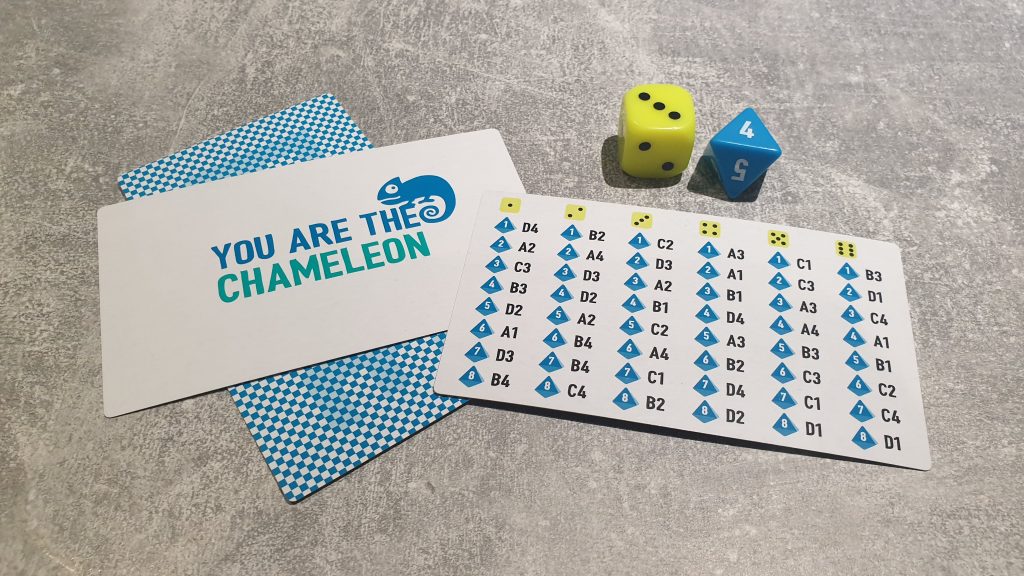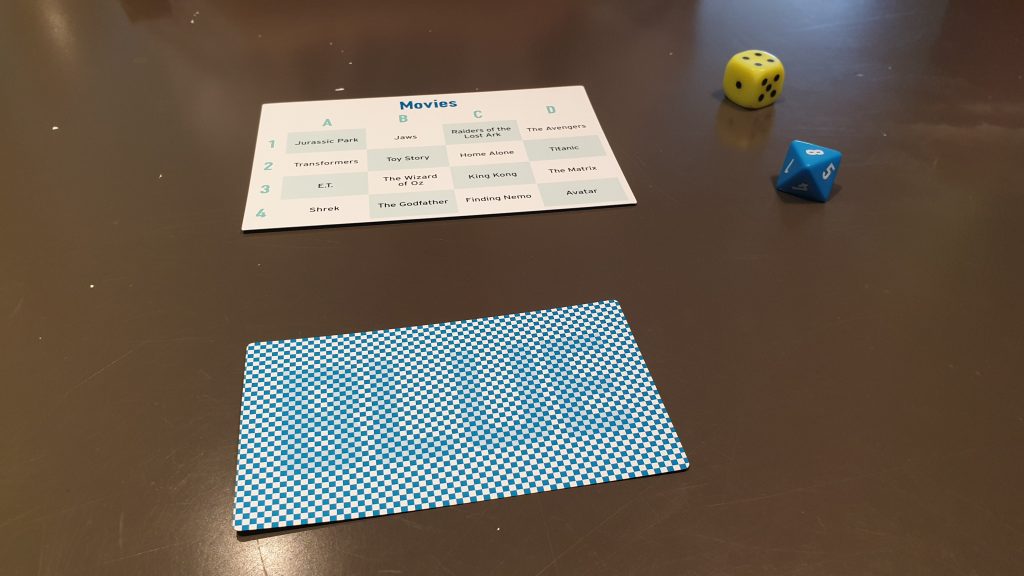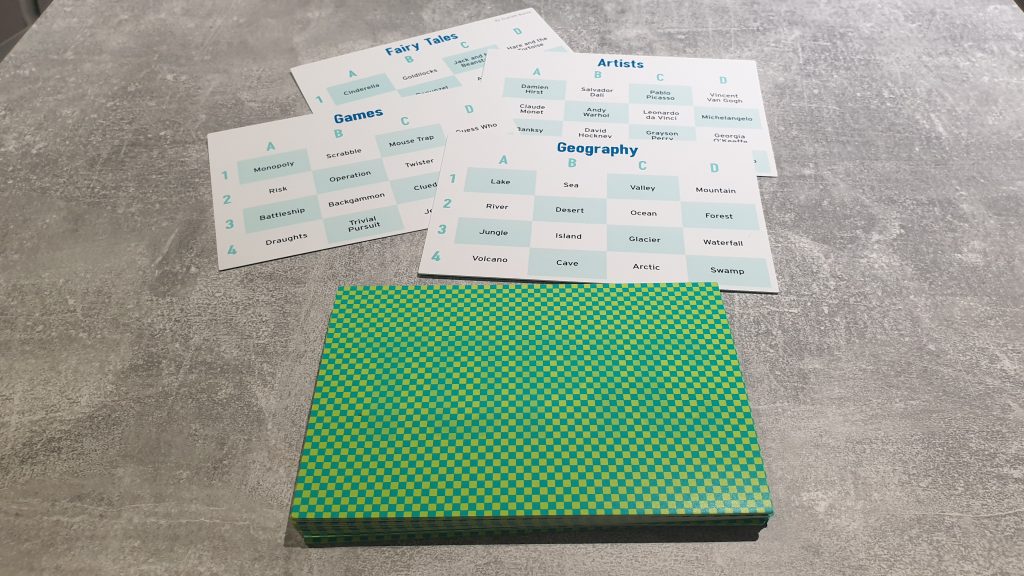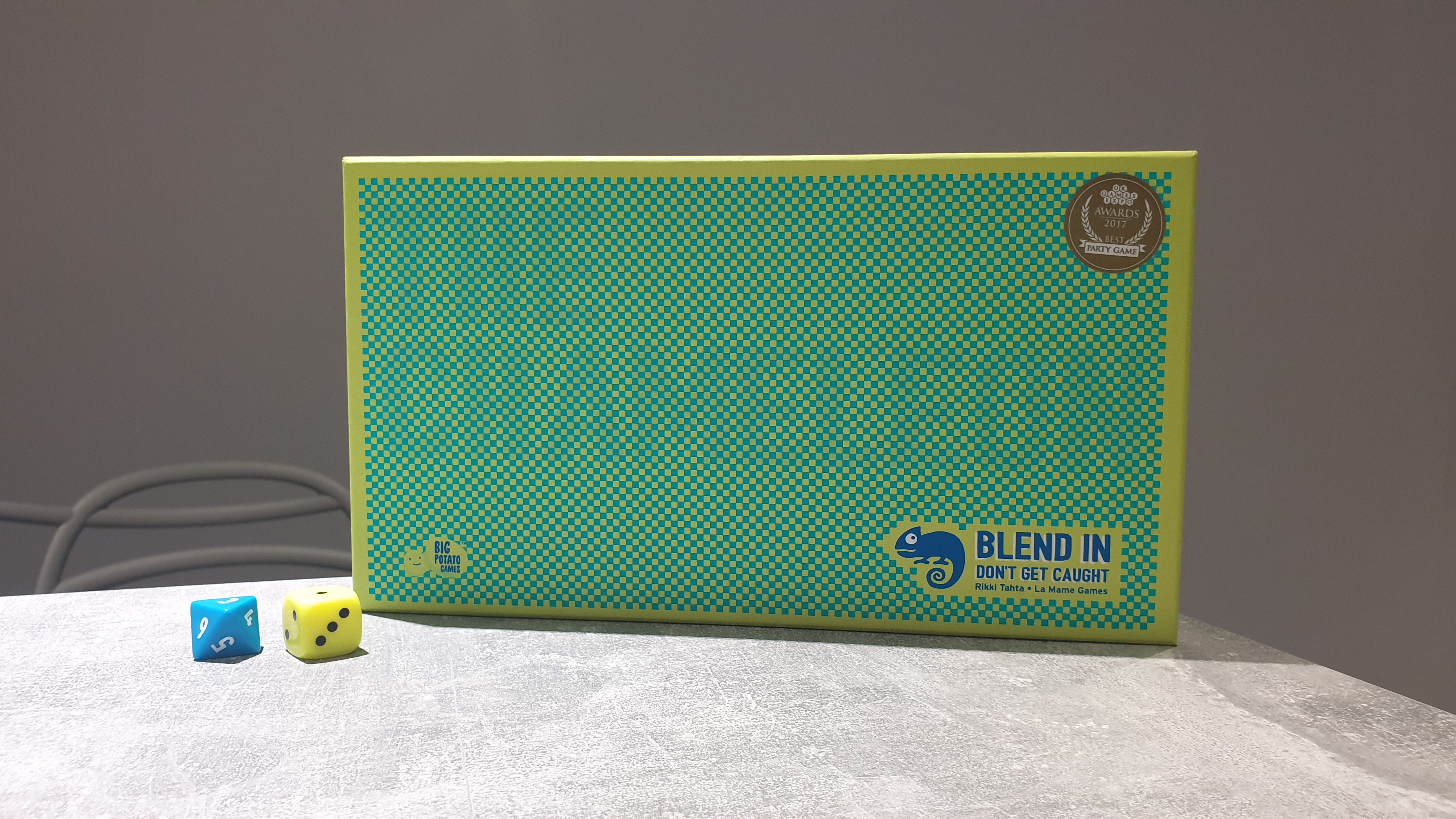The Chameleon is a party game with deduction and bluffing, released in 2017 by publisher Big Potato Games. Designed by Rikki Tahta, the game sees 3 – 8 players either attempting to find out whom the chameleon is or trying to blend in with the crowd. Individual rounds take a matter of minutes, with a variety of topics to cover. However, does the game itself blend in or stand out? Let’s find out!
Grabbing the dice, topic cards and player cards from the box The Chameleon is almost ready to go. Place one topic card in the middle of the table, or playing area. Sorting out the player cards is a simple task. Select either the Blue or Green deck (included for variety). Then, including the special chameleon card, draw a number of cards equal to the player count and return the rest to the box.
At the start of the game anyone can roll the dice, though in future rounds whomever was last the Chameleon player rolls and deals the cards. There are two different dice a yellow 6 sided die and a blue 8 sided dice. On the non-chameleon player cards this dice roll will indicate a coordinate on the Topic card grid. For example rolling a 4 on the yellow die you’d go four along the top then down by whatever was rolled on the blue die. This would say something like A3 or C1.

The Topic cards are a 4 by 4 grids with 1 – 4 along the side and A – D along the top. Using the coordinates from the player cards everyone bar the chameleon player will know the secret word for the round. With Topic cards ranging from Countries to Food – and many things in between – the word could be Dungeon, Aladdin or other entertaining things. This sounds like a lot of things to do to set up only a single round. Thankfully, explaining this step can be demonstrated super easily with the components. Plus, in reality, it’ll only take a matter of seconds once the game is in full flow.
Once the word is selected the player to the left of the dice roller starts the round by saying a single word. This word should be loosely related to the secret word. The hook is that the Chameleon will not know the word at all. Instead they will have to glean information from the single words said and the grid of potential words on the Topic card. These are well balanced with specific words often managing to cover a few potential answers. Note, if the word is Giraffe saying “neck” is probably too obvious but “savanna” might be vague enough. Going clockwise everyone must say a word and hesitation isn’t always helpful to your cause.
Once everyone has said a word it is time to vote who the Chameleon was. Everyone, including the still unrevealed chameleon, gets a vote – with ties split by the dice roller. The voted for person reveals their player card – showing if they were the chameleon or not. If the chameleon is not selected they win the round, though even if chosen by the vote they have a final chance to win. By guessing the secret word they still win, hence the players in the know need to be vague.

The game can go on for as many rounds as the group wants – with players cards then shuffled and re-dealt. While enjoyable just for some fast fun players can choose to score to give an overall winner. Rather than just playing as many rounds as you wish – this turns the game into a race to 5 points. If the Chameleon player blends in and isn’t voted by the group they get 2 points. If they are voted as the Chameleon but guess the secret word they score 1 point. The rest of the players only score if the Chameleon is found and they don’t guess the word – which is worth 2 points.
From time to time it is best to change the topic card to keep things fresh. This doesn’t need to be done regularly – with some of the fun coming from hinting to the same word multiple times or at least about the same topic. This forces players to be more creative or the Chameleon will get an easy point or two. Whilst there are many topic cards included there is also the opportunity for players to create their own with a large blank card and dry wipe marker in the box. It is surprisingly hard to make cards as good as in the box unless you go super specific with things about a favourite film or game – though it opens the game up for unique experiences.
One of my biggest grips with similar titles is that the questions or words given can be anything. For example, in Spyfall bad questions simply cause the game to become okay at best. There is a structure to The Chameleon that causes everything to be focused. If the topic in the middle of the table is animal the words said will have some loose link to animals, whether you are trying to blend in or not. By extension the pressure felt if the hidden role player is first is much lower as they know the topic and just have to hope their word is in the right ballpark.

While the pressure is lessened it is still there, though not only for the hidden role player. Everyone needs to give a good word. While the player blending in wants to stay hidden the other players cannot be too be vague thus attract the attention towards themselves. Some players do get a little flustered when on the spot. This seems to be especially a problem if The Chameleon starts a round – being sat next to the dealer. The quickness of rounds results in these slightly awkward round fails to be swiftly moved on from though.
The player cards seem to daunt a few players, at least until they’ve played a round. They squeeze a lot of information onto a card so aren’t perfect for just glancing at. I’ve personally misread them a few times – though seem to be the only person to manage this. This was mostly from mixing the colours of the dice up – not that I am colourblind or that the colours are similar I just completely misreading them.
There aren’t many games that can be taught quicker than The Chameleon. What’s better is that it is super easy to play a round while explaining how to play. For all of those gamers that say “let’s just play” there is a game where no rules can be accidentally skipped via this method. The simplicity allows the game to not only hit the table running but players can drop in and out. Even if scoring, new players can spend a minute watching a round and know how to play. This has made it a hit at lunch and gatherings being fun without having a definitive time input requirement.
The Chameleon doesn’t revolutionise the deduction and hidden role genre. What it does it take the logic of multiple games, being similar to the likes of Spyfall, and condenses the experience into 2 – 3 minute rounds. The round itself can sometimes only be half of this time, with players laughing, complaining about what others were thinking and normally a good portion of banter making up the rest. Plenty is included in the box to keep the game fresh each time the game hits the table. It won’t be a game to play for hours on end but The Chameleon will be a go to game for many social occasions when quick fun is called for!
[Editor’s Note: The Chameleon was provided to us for the review by Big Potato Games.]

